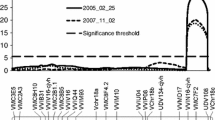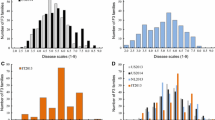Abstract
204 genotypes of cauliflower were screened against downy mildew (DM) through challenge inoculation during 2019–20 and 2020–21 and 12 genotypes were identified as resistant (DS < 1). The disease reaction of the genotypes was recorded under natural infection conditions at curding and flowering stages. The DM score at the flowering stage showed a strong positive correlation with challenge inoculation (r2 = 0.614). The inheritance of downy mildew resistance was determined using 10 F2s populations developed from three susceptible(S) varieties (Pusa Himjyoti, Pusa Sharad, Pusa Meghna) and five resistant (R) genotypes (BR-2, 3–5–1-1, CCm, BR-207, BR-161). The F2 plants expressed segregation into R and S plants as per the expected Mendelian ratio of 3:1 (p = 0.3–0.7) and revealed the monogenic dominant nature of resistance. The segregation of 118 F2:3 progenies and 121 RILs from Pusa Himjyoti × BR-2 and two confirmatory F2s from S × S (Pusa Himjyoti × Pusa Sharad) and R × R (3–5–1-1 × CCm) also confirmed the single gene inheritance. Uniform segregation ratio in diverse resistance sources along with three different susceptible backgrounds established the single gene theory of DM resistance in Indian cauliflower germplasm. These new sources for downy mildew resistance having a simple Mendelian inheritance patterns can be directly used in resistance breeding.





Similar content being viewed by others
References
Achar, P. N. (1998). Effects of temperature on germination of Peronospora parasitica conidia and infection of Brassica oleracea Journal of Phytopathology, 146, 137–141.
Carlsson, M., Bothmer, R., & Merker, A. (2004). Screening and evaluation of resistance to downy mildew (Peronospora parasitica) and clubroot (Plasmodiophora brassicae) in genetic resources of Brassica oleracea Hereditas-Lund., 141(3), 293–300.
Coelho, P., Leckie, D., Bahcevandziev, K., Valério, L., Astley, D., Boukema, I., et al. (1998). The relationship between cotyledon and adult plant resistance to downy mildew (Peronospora parasitica) in Brassica oleracea Acta Horticulturae, 459, 335–342.
Coelho, P. S., & Monteiro, A. A. (2003). Inheritance of downy mildew resistance in mature broccoli plants. Euphytica, 131(1), 65–69.
Dickson, M. H., & Petzoldt, R. (1996). Seedling downy mildew resistance in B. oleracea Crucifer Newsletter, 18, 108–109.
Dickson, M. H., & Petzoldt, R. (1993). Plant age and isolate source affect expression of downy mildew resistance in broccoli. Journal of Horticultural Science, 28, 730–731.
Farnham, M. W., Wang, M., & Thomas, C. E. (2002). A single dominant gene for downymildew resistance in broccoli. Euphytica, 128(3), 405–407.
Gaikwad, A. P., Kakade, D. S., Nimbalkar, C. A., & Desai, U. T. (2004). Control of downy mildew (Peronospora parasitica) of cauliflower (Brassica oleracea L. var. botrytis) in nursery. Indian Journal of Agricultural Sciences, 74, 230–232.
Heath, M. C. (2009). A personal perspective of the last 40 years of plant pathology: Emerging themes, paradigm shifts and future promise. Annual Plant Reviews, 34, 1–15.
Jensen, B. D., Hockenhull, J., & Munk, L. (1999). Seedling and adult plant resistance to downy mildew (Peronospora parasitica) in cauliflower (Brassica oleracea var. botrytis L.). Plant Pathology, 48, 604–612.
Mahajan, V., Gill, H. S., & Singh, R. (1991). Screening of cauliflower germplasm lines against downy mildew (Peronospora parasitica). Crucifer Newsletter, 14/15, 148–149.
Mahajan, V., Gill, H. S., & More, T. A. (1995). Inheritance of downy mildew resistance in Indian cauliflower (group III). Euphytica, 86, 1–3.
Meena, M. L., Sharma, S. R., & Kalia, P. (2004). Screening of cauliflower germplasm against black rot (Xanthomonas campestris). First Indian Horticulture Congress, New Delhi, India. 80. (Abstract).
Monot, C., & Silue, D. (2009). Comparison of the resistance and susceptibility to downy mildew [Hyaloperonospora parasitica, constant. (Pers. ex Fr)] of nine Brassica oleracea accessions in laboratory, seedbed, and field screens. Euphytica, 169, 413–419.
Monteiro, A. A., Coelho, P. S., Bahcevandziev, K., & Valerio, L. (2005). Inheritance of downy mildew resistance at cotyledon and adult-plant stages in ‘Couve Algarvia’ (Brassica oleracea var. tronchuda). Euphytica, 141(1), 85–92.
Pandey, K. K., Pandey, P. K., Singh, B., Kalloo, G., & Kapoor, K. S. (2001). Sources ofresistance to downy mildew (Peronospora parasitica) disease in Asiatic group of cauliflower. Vegetable Science, 28(1), 55–57.
Panse, V.G. and Sukhatme, P.V. (1967). Statistical methods for agricultural workers, Indian Council of Agricultural Research, New Delhi, India. pp. 152–157.
Sadik, S. (1962). Morphology of the curd of cauliflower. American Journal of Botany, 49, 290–297.
Saha, P., Ghoshal, C., Ray, S., Saha, N. D., Srivastava, M., Kalia, P., & Tomar, B. S. (2020). Genetic analysis of downy mildew resistance and identification of molecular markerslinked to resistance gene Ppa207 on chromosome 2 in cauliflower. Euphytica, 216(11), 1–13.
Saha, P., Kalia, P., Sharma, M., & Singh, D. (2016). New source of black rot disease resistance in Brassica oleracea and genetic analysis of resistance. Euphytica, 207, 35–48.
Saharan G.S., Mehta N., Meena P.D. (2017). Epidemiology and forecasting. In: Downy mildew disease of Crucifers: Biology, Ecology and Disease Management. Springer, Singapore. https://doi.org/10.1007/978-981-10-7500-1_9.
Sen, B., Trivedi, B. M., & Singh, R. (1991). Disease situation in north western plains of India. Indian Phytopathology, 45, 263 (abstract).
Sharma, B. R., Swarup, V., & Chatterjee, S. S. (1972). Inheritance of resistance to blackrot in cauliflower. Canadian Journal of Genetics and Cytology, 14(2), 363–370.
Sharma, S. R., Kapoor, K. S., & Gill, H. S. (1995). Screening against sclerotinia rot (Sclerotinia sclerotiorum), downy mildew (Peronospora parasitica) and black rot (Xanthomonas campestris) in cauliflower (Brassica oleracea var botrytis subvar. cauliflora). Indian Journal of Agriculture Science, 65(12), 916–918.
Sharma, S. R., Singh, P. K., Chable, V., & Tripathi, S. K. (2005). A review of hybrid cauliflower development. Journal New Seeds, 6, 151–193.
Singh, B.D. (2003). Genetics. Kalyani publication, Ludhiana, India. pp. 155–180.
Singh, R., and Sharma, S. R. (2003). “Cauliflower” in textbook on vegetables, tuber crops and spices, eds. S. Thamburaj and N. Singh (Indian Council of Agricultural Research, New Delhi), 76–97.
Singh, S., & Kalia, P. (2021). Advances in cauliflower (Brassica oleracea var. botrytis L.) breeding, with emphasis on India. In Advances in plant breeding strategies: Vegetable crops (pp. 247–301). Springer.
Singh, S., Sharma, S. R., Kalia, P., Sharma, P., Kumar, V., Deshmukh, R., & Sharma, T. R. (2012). Molecular mapping of the downy mildew resistance gene Ppa3 in cauliflower (Brassica oleracea var. botrytis L.). The Journal of Horticultural Science and Biotechnology, 87(2), 137–143.
Singh, S., Sharma, S. R., Kalia, P., Sharma, P., Vinod Kumar, R., Meena, B. L., et al. (2013). Screening of cauliflower (Brassica olerecea L. var. botrytis L.) germplasm for resistance to downy mildew {Hyaloperonospora parasitica constant (Pers.:Fr) Fr.} and designing appropriate resistance breeding strategies. The Journal of Horticultural Science and Biotechnology, 88(1), 103–109.
Swarup, V., & Chatterjee, S. S. (1972). Origin and genetic improvement of Indian cauliflower. Economic Botany, 26, 381–393.
Ton, J., Pieterse, C. M. J., & Loon, L. C. (2006). The relationship between basal and induced resistance in Arabidopsis In S. Tuzun & E. Bent (Eds.), Multigenic and induced systemic resistance in plants (pp. 197–224). Springer Science.
Verma, T. S., & Thakur, P. C. (1989). Comparative field resistance of cabbage collection to downy mildew at the seedling stage. Indian Journal of Plant Protection, 17, 79–80.
Verma, A., & Singh, Y. V. (2018). Inheritance of downy mildew resistance and its relationship with biochemical traits in cauliflower (Brassica oleracea L. var. botrytis). Crop Protection, 106, 132–138.
Vicente, J. G., Gunn, N. D., Bailey, L., Pink, D. A. C., & Holub, E. B. (2012). Genetics of resistance to downy mildew in Brassica oleracea and breeding towards durable disease control for UK vegetable production. Plant Pathology, 61(3), 600–609.
Vishunavat, K., Nashaat, N. I., Heran, A., & Kolte, S. J. (1998). Sensitivity to the racemic mixture and isomeric forms of metalaxyl in Indian and European homothallic and heterothallic isolates of Peronospora parasitica in Brassica species. Crop Protection, 17(6), 543–546.
Verma, V. K., Kalia, P., & Prasanna, B. M. (2017). Genetic characterization of self-incompatible lines and strategies for heterosis breeding in cauliflower. International Journal of Vegetable Science, 23(5), 411–429.
Acknowledgements
The authors express thanks to Director, IARI, New Delhi for facilities. The part of the study was from the first author’s Ph.D. thesis. Hence, we acknowledge PG School, IARI, New Delhi. We thank ICAR for CRP Hybrid Technology Project [Project Code: IARI/CRPHT-12-142-F (Cauliflower)] for financial support for part of the work. We thank Head, IARI RS, Katrain, Himachal Pradesh, India for sharing 20 lines of late cauliflower.
Author information
Authors and Affiliations
Corresponding author
Ethics declarations
Conflict of interest
The authors declare no conflict of interest and that the research complies with ethical standards. This research does not involve any human participants and/or animals.
Supplementary Information
Below is the link to the electronic supplementary material.
Supplementary file 1
(DOCX 36.8 kb)
Rights and permissions
About this article
Cite this article
Singh, S., Kalia, P. & Sharma, S.R. New sources of downy mildew resistance in cauliflower and their prospects in resistance breeding. Eur J Plant Pathol 163, 813–826 (2022). https://doi.org/10.1007/s10658-022-02517-7
Accepted:
Published:
Issue Date:
DOI: https://doi.org/10.1007/s10658-022-02517-7




